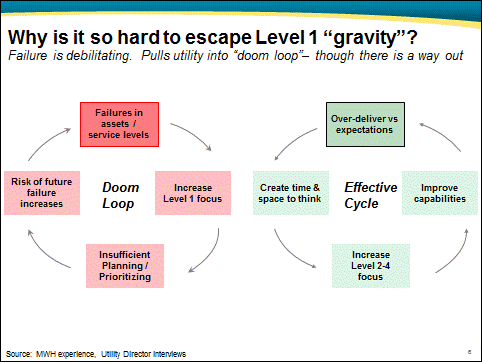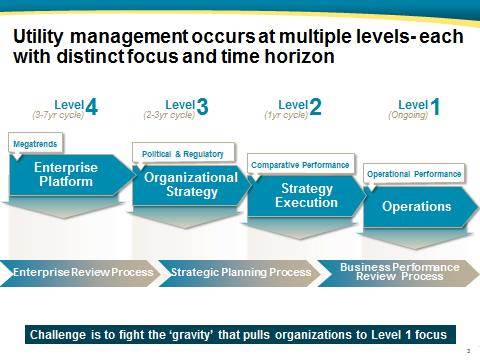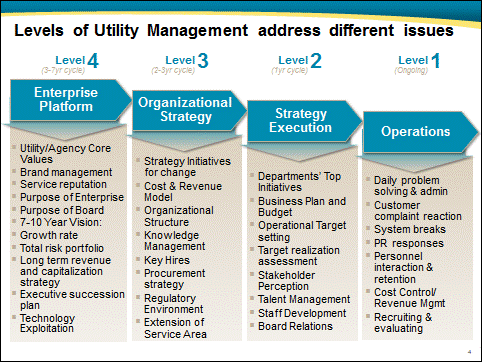Mac Hodell, global director of management consulting – strategic planning services
Consider this hypothetical: Organization X is permanently on defense. Leaders rush from one crisis to the next – triaging, conducting damage control, answering ‘higher’ and repeating. Planning meetings are routinely postponed. What meetings do occur are ineffective as attention wanes and iPhones come out to attend to the latest operational issue. Operational and organizational data are not trusted – rendering analysis and comparison ineffective. Key people retire without backfills in place, resulting in loss of knowledge and further inefficiency…
This is the portrait of an organization out of control. Among all their issues, perhaps the most acute is that the leadership team is not operating at the right “level of thinking.” I make this claim because, until this changes, the negative cycle described above will persist.
So what is this organization to do?
A good place to start is to consider how much time and focus goes to which kinds of issues. Our observation is that organizational / utility management can be viewed as occurring at a number of “levels,” each with a different focus and a different time horizon.
- Level 1: Operations level – managers are focused on day to day issues.
- Level 2: Strategy execution – generally at the annual planning cycle level.
- Level 3: Organizational strategy – expands to two to three years and the focus expands to organizational strategy issues with regulatory and longer term political forces taken into account.
- Level 4: Enterprise – relook at the overall enterprise taking into account megatrends and looking out five to seven years.
The point being: excessive focus on the day-to-day operations compromises long term viability.
The levels and typical considerations for each are illustrated below:
By way of background, this framework was initially developed as an MWH internal management tool. Our former CEO, Bob Uhler, wanted to ensure the executive team spent the appropriate amount of energy on longer-term strategic issues versus day-to-day tactics. This simplified view was helpful in diagnosing when meetings and interactions were slipping down below their intended level. We tested this thinking with clients to see if it resonated. Given the special demands utility leadership teams face, we’ve found it to be highly relevant.
It’s worth asking why this pattern exists. Our observation is that there is an organizational “gravity” that, unless actively opposed, tends to pull meetings, interactions and time allocation down towards “Level 1.” Why? One common answer is that tangible operational needs can take clear precedence over less visible, less immediate planning. Addressing operational crises feels good. It creates an adrenaline rush.
So what? The issue is that if the top leadership is not looking out over the horizon, no one is. This invites disaster.
The dilemma can be illustrated in this graphic:
 Addressing this challenge is not easy, but there are steps to take to counteract this effect. Note that these cycles work both ways: even if things are bad, starting to find and deliver quick wins builds positive momentum.
Addressing this challenge is not easy, but there are steps to take to counteract this effect. Note that these cycles work both ways: even if things are bad, starting to find and deliver quick wins builds positive momentum.
Here are some practical steps an organization can take.
First: eliminate failure. It has a ‘multiplier’ effect.
- Triage issues; focus resources on root causes/bottlenecks: This requires some deliberate analysis of where failures are happening and why. Invest the time in this.
- Resist the “adrenaline rush” allure of firefighting.
Second: proactively manage expectations. Create small “wins.”
- Set achievable targets; manage progress towards them rigorously.
- Proactively engage stakeholders; demonstrate accountability and progress. Get on offense with customers, the board, the regulator and the elected officials.
Third: adjust the governance model.
- Allocate some time and energy (about three hours/month) to level 3 and 4 issues via “executive leadership committee meetings.” Protect this time and agenda.
Fourth: re-allocate time of top talent
- Mayor / Council ‘firedrills’ are a fact of life, but insulate some key staff from this and ensure they are driving longer-term initiatives.
- Consider the emerging leaders, perhaps three to four layers down in the organization: ensure they have stretch roles, perhaps leading strategic initiatives that get at fundamental root causes of current issues.
- Consider the soon-to-retire operational experts: engage them now with documenting standard operating procedures and developing backfill talent.
Now, think about your organization and consider the following questions:
- Does the top leadership team routinely spend more than half of its time focused on day-day operations (“Level 1”)?
- Does the organization have a living strategic plan that is currently reflected in actual initiatives being implemented and tracked?
- Does the organization have a living succession plan informed by future looking supply / demand views of key positions?
If you answered ‘no’ or were unsure of the answers to any of these questions, your organization might benefit from re-calibrating your levels of thinking.
©2014 MWH Global, Inc.


